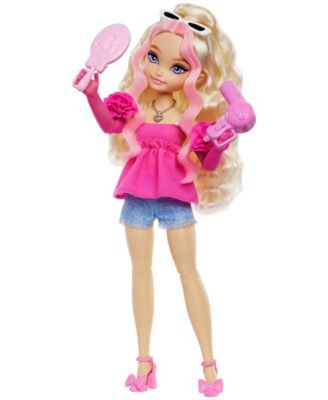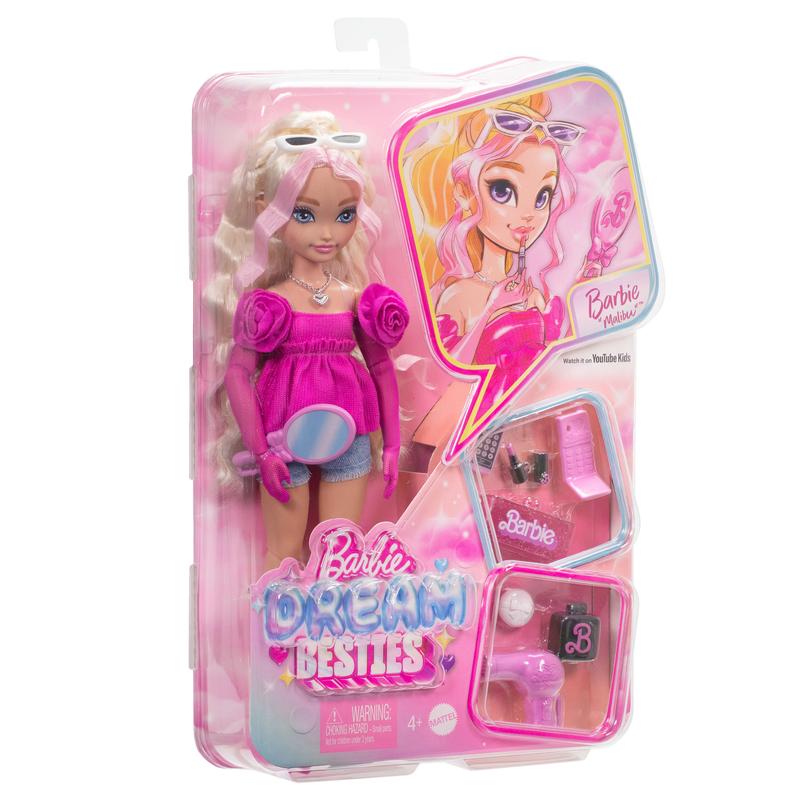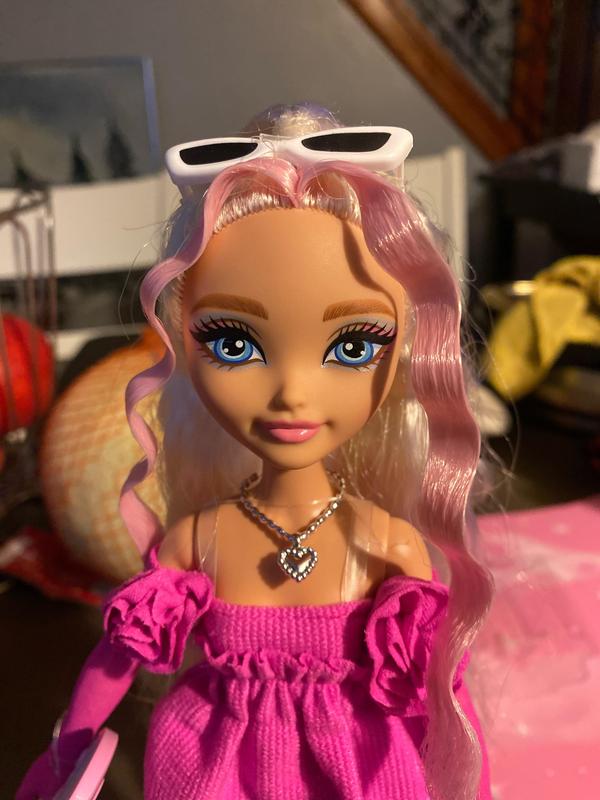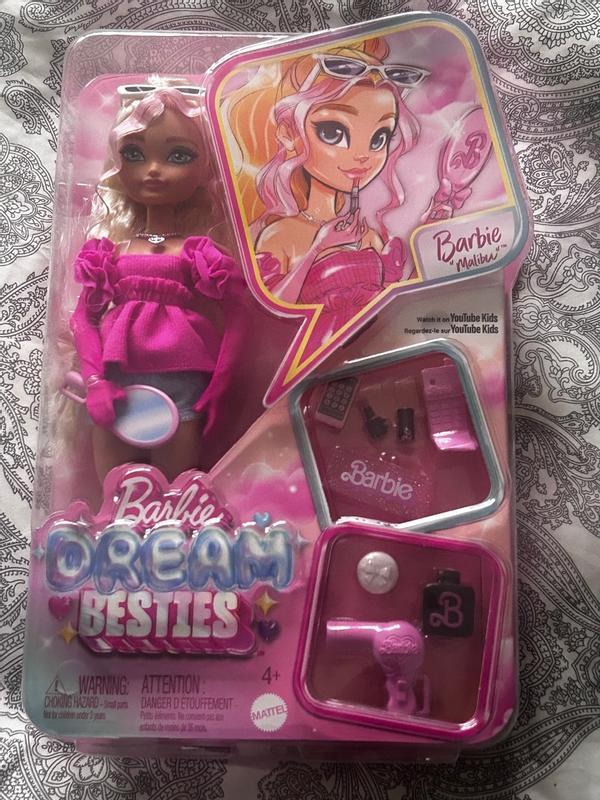Dream Besties Barbie Malibu Doll and Accessories
Product details
Web ID: 1880166546 reviews
Finally Barbie Back!
Finally shelves filling up with new Barbies. Like the ones that come with accessories.
Such a great little Barbie doll
Such an adorable little Barbie doll! She comes with such cute accessories too such as a purse, phone, mirror, hair dryer, gloves and more. Her arms and legs are flexible too so posing while playing with her is really fun!
Recommends this product

Customer review from shop.mattel.com
HORRIBLE OMG COPYCAT DOLL!!!!!!!!! NOT BARBIE!
This line of dolls are atrocious, this is not BARBIE! This is a wannabe OMG doll which is pathetic. Mattel you need to stick to the original Barbie design, trying to modernize these dolls to look like every other doll on the market is just stupid. My seven year olds hates this styling of the doll, the accessories are even bad! JUST WHY DID YOU SO THIS- YOU ARE RUINING BARBIE!!! They pretty much all have the same face and why are their behinds so big, is that necessary? Go back to the original line and ditch this garbage please!!!!!!

Customer review from shop.mattel.com
Love it
Great doll with cute accessories (although not sure how long it will be until the little bits get lost or hoovered up). Doll and packaging is really eye catching.

Customer review from influenster.com
Great toy
The Evolution of Barbie: A Cultural Icon and Its Impact Barbie, the iconic fashion doll created by Ruth Handler and introduced by Mattel in 1959, has long been more than just a children's toy. Over the decades, she has evolved into a multifaceted symbol of societal shifts, gender roles, and cultural changes. As one of the most recognizable and enduring figures in popular culture, Barbie’s journey reflects not only the changing tastes of the toy industry but also broader transformations in gender expectations, beauty standards, and representation. The Birth of Barbie Barbie’s debut at the American International Toy Fair in New York on March 9, 1959, marked the beginning of a revolutionary shift in the toy world. Ruth Handler, inspired by the European fashion dolls she had seen during a trip to Germany, envisioned a doll that would allow young girls to imagine an adult world, offering them endless possibilities for play. Before Barbie, most dolls were baby dolls, designed to teach nurturing and caretaking roles. Barbie, however, was an adult woman with a career-oriented persona, offering a stark contrast to the nurturing mother figure. Her full name, Barbara Millicent Roberts, was an homage to Handler’s daughter, Barbara, and was intended to suggest that this new doll was more than just a toy—it was a symbol of independence and aspiration. The first Barbie doll, dressed in a black and white striped swimsuit, was a reflection of the glamorous fashions of the late 1950s. She was marketed as a teenage fashion model, with a distinct, slender figure and an elegant, mature demeanor. At the time, Barbie’s physical appearance, with her exaggerated curves and adult features, stood in stark contrast to the childlike dolls that preceded her. The Changing Image of Barbie Over the years, Barbie’s image has undergone multiple transformations, often reflecting the changing cultural attitudes towards women, beauty, and gender roles. In the 1960s and 1970s, Barbie was portrayed as a fashionable, career-driven woman with a wide variety of professions, from astronaut to doctor to business executive. This shift was reflective of the changing roles of women in society, particularly as second-wave feminism gained momentum. Barbie was marketed not just as a homemaker, but as someone who could do anything—a message that resonated with young girls who were growing up in an era of increasing gender equality. However, Barbie’s unrealistically thin, often stereotypically blonde appearance, along with her disproportionate body shape, began to draw criticism in the 1980s and 1990s. Critics argued that Barbie reinforced harmful beauty standards and unrealistic body ideals, perpetuating a narrow definition of femininity. For many years, Barbie’s physique became a point of contention, and debates over her influence on body image and self-esteem among young girls persisted. In response to these critiques, Mattel made several attempts to modernize Barbie’s image. In the early 2000s, the company introduced more diversity into the Barbie line, offering dolls of different skin tones, hair textures, and facial features. Barbie began to take on more inclusive roles, representing a wider array of identities and experiences. This shift was partly influenced by the increasing focus on representation and diversity within the media, and it marked a departure from the more homogenous and idealized version of femininity that Barbie had embodied in her earlier years. Barbie as a Cultural Reflection Barbie’s cultural relevance cannot be overstated. As a toy, she has reflected the societal values, aspirations, and anxieties of the times. During the 1960s and 1970s, as women began to push for more rights and opportunities, Barbie became a symbol of empowerment, showing girls that they could pursue careers and dreams that were traditionally reserved for men. In the 1980s and 1990s, however, Barbie’s image became tied to concerns over consumerism and the commodification of beauty. Critics accused Mattel of reinforcing harmful stereotypes by producing a doll whose unattainable physical standards could negatively influence young girls' self-esteem. In the 21st century, Barbie has been repositioned as an inclusive, empowering figure for all children, offering a broader range of possibilities for imaginative play. The introduction of dolls representing various body types—such as curvy, tall, and petite models—has helped to challenge conventional ideas of beauty, signaling Mattel's commitment to embracing diversity in its toy line. Barbie has also expanded her professional range to include more careers in science, technology, engineering, and mathematics (STEM), as well as roles that reflect the growing acceptance of non-traditional gender norms, such as gender-neutral dolls. In 2016, the brand launched the "Barbie Dream Gap Project," an initiative aimed at addressing the gender gap in self-confidence, particularly in girls aged 5 to 10. This project was inspired by research showing that girls’ self-esteem drops significantly during these formative years. Barbie’s new line of dolls, which reflected more realistic body types, ethnicities, and career aspirations, was part of a broader effort to challenge traditional gender norms and foster positive self-image in young girls. Barbie in Popular Culture Beyond the toy shelf, Barbie has had a lasting impact on popular culture. She has appeared in television specials, films, and books, often portrayed as a character who embodies the ideals of beauty, style, and femininity, yet also serves as a source of empowerment. Barbie has been a subject of satire and critique as well, with cultural figures and academics questioning her role in shaping young girls' perceptions of themselves. Yet, despite the controversy, Barbie’s influence remains undeniable. In 2023, the release of the live-action Barbie movie directed by Greta Gerwig provided a unique opportunity to engage with the doll’s cultural legacy. The film, which explores themes of identity, femininity, and societal expectations, has been praised for its self-aware critique of Barbie’s complicated legacy while celebrating the doll's role as a symbol of both empowerment and the embodiment of unrealistic standards. Conclusion Barbie’s evolution from a controversial symbol of unrealistic beauty to a more inclusive, diverse, and career-driven icon mirrors the ongoing changes in society’s views on gender, beauty, and identity. What started as a fashion doll for young girls has grown into a global phenomenon, reflecting the social issues of its time and contributing to the conversation about gender roles and representation. While the figure of Barbie continues to evolve, her enduring presence reminds us of the power of toys and media in shaping our perceptions and aspirations. As society continues to change, Barbie will undoubtedly continue to evolve—reinventing herself for the next generation, always striving to reflect both the hopes and challenges of the time.

Customer review from shop.mattel.com
A brand you can trust
The Barbie dream bestie ‘Malibu’ has a unique design! As like most Barbie merchandise is very durable and great value for your money. my daughter hasn’t stopped playing with her and she’s even taken it to school when it’s show and tell.

Customer review from influenster.com
Brilliant
This is a great product. The packaging was sturdy even tho the outside packaging was bashed the box the doll came in was in amazing condition. It is a very sturdy thick plastic doll. Price wise this is a good price for this 100% recommend.

Customer review from influenster.com
Beautiful
Such a beautiful barbie that is so well made and high quality just like the old fashioned barbies were made. Has cute little accessories that come with it. Any girl young or old would love it.

Customer review from influenster.com






